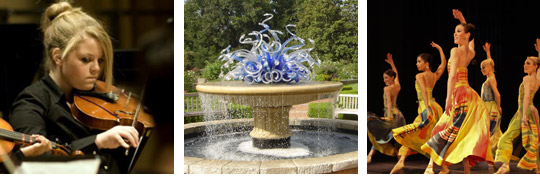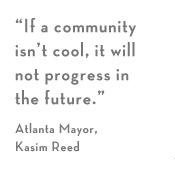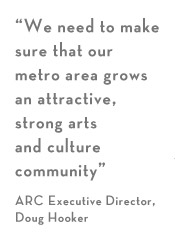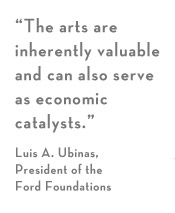Arts & Culture Part of Vibrant, Successful Metro Regions
March 2013

"If a community isn't cool, it will not progress in the future," said Atlanta Mayor Kasim Reed, while speaking at one of a series of arts and culture forums, hosted by the Atlanta Regional Commission (ARC), the region's planning agency.
The same sentiment that it takes more than a paycheck to attract the young "creative class" to a metro region, led Atlanta regional leaders to instigate a joint venture between ARC and the Metro Atlanta Arts & Culture Coalition (MAACC). Together, they conducted a cultural assessment of the Atlanta region in 2011-12. After months of collaboration, the two agreed that ARC should play a larger role in arts, culture and the creative industries in metro Atlanta.

In 2012, the Atlanta Regional Commission (ARC) added arts and culture to its planning scope, making it one of the first regional planning agencies in the U.S. to do so. Arts and culture have long been seen as important to a prosperous community, but what brought ARC to this decision?
"We believe that communities with healthy and diverse arts and culture offerings are more exciting and desirable places to live," said Doug Hooker, ARC Executive Director. "These are quality of life factors, but also they are critical economic development drivers that may have been traditionally over-looked by regional planning agencies."
The cultural assessment found that metro Atlanta was already home to 1,740 cultural, non-profit organizations that generate $502 million in revenues annually and hold $1.8 billion in assets. There are 15,326 arts-related businesses in the 10-county region that employ 62,310 people. The City of Atlanta has the second highest number of arts-related businesses per capita of the 100 most populated U.S. cities, and Fulton County ranks fourth among the 100 most populated counties.
The cultural assessment found that metro Atlanta was already home to 1,740 cultural non-profit organizations that generate $502 million in revenues annually and hold $1.8 billion in assets. There are 15,326 arts-related businesses in the 10-county region that employ 62,310 people. The City of Atlanta has the second highest number of arts-related businesses per capita of the 100 most populated U.S. cities, and Fulton County ranks fourth among the 100 most populated counties.
When it comes to the draw of metro Atlanta's arts scene, the cultural assessment sampled more than 1.7 million ticket transactions at the region's 11 largest venues. These transactions represented patrons from all 50 states.
Diverse Group Steers the Ship


To help bring these numbers to life and open more arts and culture opportunities and awareness, ARC created an Arts & Culture Advisory Committee that includes arts and cultural non-profits, artists, planners and business leaders. This committee is helping ARC to establish its priorities and develop guidelines for moving forward in developing a Regional Cultural Master Plan.
“The Arts and Culture Advisory Committee is guiding our efforts to incorporate the arts and culture perspective into everything we do – from transportation and land planning, to community and workforce development services,” said Mr. Hooker. “Thanks to technology, more and more people are able to perform their jobs from wherever they choose to live. We need to make sure that our metro area grows an attractive, strong arts and culture community.”
Trends Around the U.S.
Arts and culture communities in other metro regions around the country are progressing in innovative, thought-provoking ways.
The Trey McIntyre Project in Boise, Idaho has local hospitals incorporating dance studios into their facilities and housing dance companies on site. Studies are showing that interaction with the arts reduces the length of hospital stays.
Several North Carolina communities are benefitting from the Art-Force program, in which local ArtPlace, local economic development authorities and manufacturers partner with artists. An artist sets up shop in an under-capacity manufacturing facility and the manufacturer helps produce work that is conceived and/or designed by the artist.
Closer to home, in the metro Atlanta suburb of Stone Mountain, the Stone Mountain Art (SMArt) project has redeveloped shuttered downtown businesses into artist incubator spaces that attract more shoppers to the downtown area and provide business training and studio space for artists.
Planning for Arts & Culture in Metro Atlanta

By bringing arts and culture planning under the ARC umbrella, which already includes land use, transportation, water, aging services and workforce development, arts and culture will be considered as a dimension of all planning efforts, rather than as simply something nice to have. For example, when a community receives funding for a project through ARC’s Livable Centers Initiative, ARC encourages local planners to always consider how changes impact the arts community and, when appropriate, recommends that the arts bea focus of a downtown redevelopment or of the rebirth of a corridor.
Arts and culture have proven to be valuable commodities for local communities and for metropolitan regions, not just because a vibrant arts scene enhances quality of life, but because it enhances economic development. Arts venues draw visitors from inside and outside the local community or companies looking to relocate, giving the local economy a boost and rallying the community behind something that everyone realizes is a benefit. And, in today’s world of digital entertainment, gaming, blogging and TV/movie production – creative industries’s jobs can be lucrative careers for the region’s workforce.

“We need to communicate that the arts are as important as ever, that they can’t be left behind, that they can’t be dropped to the cutting-room floor,” Luis A. Ubinas, president of the Ford Foundation, told the New York Times. “Too many people think of the arts as luxuries, as jewels, things that may not be necessary in times of need, things that can be put off. The arts are inherently valuable.”
For all of these reasons, ARC is working to turn its cultural assessment into a cultural master plan for the Atlanta region. “We intend for this regional plan to help grow the arts and culture scene in neighborhoods from the region’s core to its outer suburbs,” says Mr. Hooker. “After all, it is arts and culture that add color, music, drama and soul to our lives and to all of our unique places across America.”
|